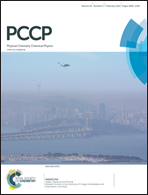Highly conductive poly(3,4-ethylenedioxypyrrole) and poly(3,4-ethylenedioxythiophene) enwrapped Sb2S3 nanorods for flexible supercapacitors†
Abstract
Composites of poly(3,4-ethylenedioxypyrrole) or PEDOP and poly(3,4-ethylenedioxythiophene) or PEDOT enwrapped Sb2S3 nanorods have been synthesized for the first time for use as supercapacitor electrodes. Hydrothermally synthesized Sb2S3 nanorods, several microns in length and 50−150 nm wide, offer high surface area and serve as a scaffold for coating conducting polymers, and are a viable alternative to carbon nanostructures. Fibrillar morphologies are achieved for the PEDOP–Sb2S3 and PEDOT–Sb2S3 films in contrast to the regular granular topologies attained for the neat polymers. The remarkably high nanoscale (∼5 S cm−1) conductivity of the Sb2S3 nanorods enables facile electron transport in the composites. We constructed asymmetric supercapacitors using the neat polymer or composite and graphite as electrodes. High specific capacitances of 1008 F g−1 and 830 F g−1 (at 1 A g−1), enhanced power densities (504 and 415 W kg−1) and excellent cycling stability (88 and 85% capacitance retention at the end of 1000 cycles) are delivered by the PEDOP–Sb2S3 and PEDOT–Sb2S3 cells relative to the neat polymer cells. A demonstration of a light emitting diode illumination using a light-weight, flexible, supercapacitor fabricated with PEDOP–Sb2S3 and carbon-fiber cloth shows the applicability of Sb2S3 enwrapped conducting polymers as sustainable electrodes for ultra-thin supercapacitors.


 Please wait while we load your content...
Please wait while we load your content...